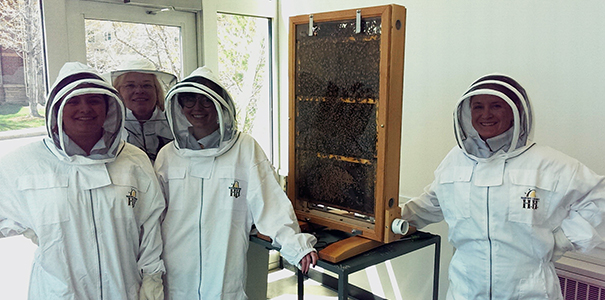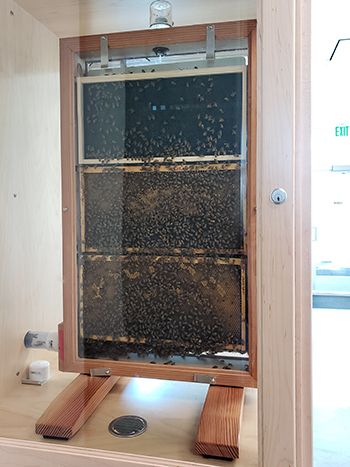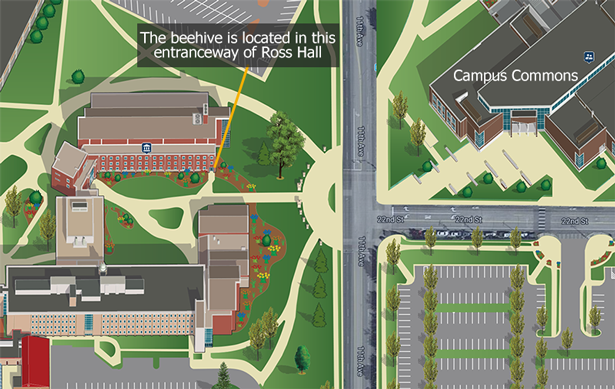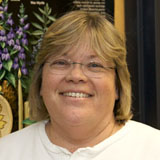
 The University of Northern Colorado has new tenants on campus — thousands of them!
In Ross Hall, an observable bee hive was installed with hardworking honeybees fortifying
their new home.
The University of Northern Colorado has new tenants on campus — thousands of them!
In Ross Hall, an observable bee hive was installed with hardworking honeybees fortifying
their new home.
School of Biological Sciences Professor Teresa Higgins, Ph.D., and Elementary Teacher Education students Ness Medina and Mollie Brandt spent the past year preparing for the beehive as well as taking beekeeping classes through the Northern Colorado Beekeepers Association. The cabinet that contains the actual, glass-encased hive was created and installed by UNC Facilities.
The observable bee hive will be used for students to study bee behavior and to integrate such activity into the classroom. For example, a research study will be incorporated into the BIO 111 course that will focus on the bees.
From worker bees to drones, nurse bees and, of course, the queen, you’ll see all types of bee behaviors. This includes observing bees making beeswax, cleaning the hive, and caring for the queen as well as the eggs, larvae and pupae, also known as the brood.
Another activity you’ll see is the waggle dance, which is how honeybees communicate the location of nectar. Certain bees have the role of searching for flowers and returning to the hive to inform other bees by performing a figure-eight dance. This tells the other bees the distance and location of the flowers using the position of the sun and the direction from the beehive.
When a worker bee finds a good source of nectar, they'll return to the hive with their collection of pollen or nectar then perform the waggle dance to show others where to go. In this 'dance,' the bee communicates two things: the direction to travel based on the sun's position as well as the distance from the hive.
While performing the waggle dance in the hive, the angle of the 'waggle run' from an imaginary perpendicular vertical line (up and down) conveys the angle to fly in relation to the sun’s position in the sky; the shorter the waggle run, the closer the location. Finally, the bee doing the dance has pollen on their legs, and the scent from the pollen is another detail that other bees will use to help identify the location.
You’ll see bees with small orange patches on their hind legs, which is collected pollen, as well as some of the honeycomb holes sealed over where the broods grow and the nurse bees minding them.
Watch a video of the hive in action:
The public is welcome to visit the hive whenever the building is open (8 a.m.-5 p.m., Monday-Friday, see map below).

 “The more we can help people understand what these organisms do and why they’re important
to our world, the better, especially in the eastern half of Colorado where it’s agricultural-based,”
said Higgins (image at left). “We rely on these organisms to pollinate our plants; it’s a symbiotic relationship
where they’re helping our plants and getting the food they need for their hive.”
“The more we can help people understand what these organisms do and why they’re important
to our world, the better, especially in the eastern half of Colorado where it’s agricultural-based,”
said Higgins (image at left). “We rely on these organisms to pollinate our plants; it’s a symbiotic relationship
where they’re helping our plants and getting the food they need for their hive.”
You can help pollinators like honeybees in your own backyard by planting pollinator plants and even becoming a beekeeper.
“There’s a bunch of different plants that produce a lot of pollen and are great for bees,” said Brandt. “Anyone can become a beekeeper as the process is not difficult, but you should research what you’re getting yourself into and that you’re in line with the HOA or other community policies.”
Another way to help pollinators is to understand how pesticides and insecticides impact them. According to the Colorado Department of Agriculture, if you must use a pesticide, use the “least-toxic material possible,” and make sure to read and follow directions.
—Produced by Katie-Leigh Corder.
More Stories
-
UNC Selects New Vice President of Student Affairs
Este artículo no está en español.
-
Employees Celebrated at Annual Staff Recognition Event
Este artículo no está en español.
-
State Funding, Finances and Strategic Planning Lead Agenda in February Board of Trustees Meeting
Este artículo no está en español.
-
Open Educational Resources Save Students Nearly $500,000 in Course Costs This Past Year
Este artículo no está en español.





